(These are excerpts from my book "A History of Jazz Music")
M-Base
In 1984 a group of young New York musicians started the "M-Base Collective"
("macro-basic array of structured extemporization"). Inspired by
Ornette Coleman's "harmolodic" blend of free jazz and funk music, they defined a program
of spontaneous composition that generally mixed
free-jazz improvisation and elements of West African music.
(It was also adorned with spiritual and philosophical theories that rarely
amounted to much else than a naive excitement for primitive societies).
The resulting style was intellectual music that had a ludic appeal, basically
turning funk music into avantgarde music.
Despite the fact that they denied the existence of an M-Base style, the M-Base
style that they (willingly or unwillingly) coined was one of the most
influential of the decade.
The collective included:
saxophonists Steve Coleman and Greg Osby,
trumpeter Graham Haynes,
trombonist Robin Eubanks,
guitarist Jean-Paul Bourelly,
pianist Geri Allen,
bassist MeShell N'degecello,
vocalist Cassandra Wilson.
An influence on the saxophonists was the eccentric and emotional style of veteran saxophonist Bunky Green, notably on Places We've Never Been (february 1979).
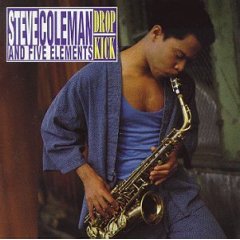
Chicago's alto saxophonist
Steve Coleman
relocated to New York in 1978
and in 1984 was instrumental in starting the M-Base Collective.
His solo debut, Motherland Pulse (march 1985), was the first manifestation of the concept (it also featured pianist Geri Allen, vocalist Cassandra Wilson and trumpeter Graham Haynes).
The M-Base Collective truly came into its own when Coleman
formed the Five Elements (with vocalist Cassandra Wilson, trumpeter Graham Haynes, electronic keyboardist Geri Allen, guitarist Kelvyn Bell, a bassist and two percussionists) and released On the Edge of Tomorrow (january 1986),
the manifesto of Coleman's non-Western forms of musical expression, in
particular his indifference towards the time signature. The idea was repeated
with less imagination on World Expansion (november 1986) and Sine Die (january 1988), despite the fact that they featured pretty much the same crowd (Wilson, Allen, Bell, Haynes, trombonist Robin Eubanks, bass, drums on the former, plus saxophonists Branford Marsalis, Greg Osby and Gary Thomas on the latter).
Steve Coleman's music sounded simply like an update to the 1990s of Ornette Coleman's harmolodic jazz of the 1980s.
Different combinations of instruments (some including Dave Holland on bass)
did not fare any better on Rhythm People (february 1990).
The "official" M-Base Collective debut albums, both credited to the
Strata Institute (basically a loose group led by Coleman and Osby), Cypher Sintax (april 1988) and Transmigration (january 1991), were actually
less representative of the movement. Coleman's involvement was marginal on
their third album, this time credited directly to the M-Base Collective,
Anatomy of a Groove (january 1992).
Though still lacking memorable numbers, Black Science (december 1990)
was a mature formalization of Coleman's aesthetic.
The first M-Base album featuring all-acoustic piano
(James Weidman), besides bass (Dave Holland), guitar and drums,
it supported the funky improvisation of the leader with
multi-layered rhythmic cycles (more or less inspired by West African music),
and it revolutionized the concept of tempo,
each instrumentalist playing in a different meter.
The result was a neurotic form of funk music, but less jarring than in the
past.
After the inferior Drop Kick (january 1992), Coleman reached another
M-Base zenith on Tao of Mad Phat (may 1993), a set of lengthy
live improvisations in the studio with more regular meters (Tao of Mad Phat, Collective Meditations, Polymaid Nomads for tentet, Little Girl on Fire).
Influenced by a trip to West Africa and ever more spiritual in nature, Coleman refined his anti-Western jazz on Def Trance Beat (june 1994)
the EP A Tale of 3 Cities (1994), credited to the Metrics (alto, tenor, piano, trumpet, bass, drums and samples) but merely a rap-jazz experiment,
and on the (uneven) trilogy derived from one live event:
Myths Modes and Means (march 1995), credited to the Mystic Rhythm
Society (sax, trumpet, koto, bass, percussion, keyboards) and containing
three colossal improvisations (Finger Of God, Song of the Beginnings, Transits),
The Way of The Cipher (march 1995), credited to the Metrics (mostly rap tunes),
and Curves of Life (march 1995), credited to the Five Elements but performed
by a keyboards-based quartet and containing two more lengthy improvisations
(Muliplicity of Approaches and Country Bama).
Despite the pretentious titles, the music was mostly light-weight funk-jazz.
The Afro-Cuban album The Sign and The Seal (february 1996), a collaboration with a Cuban band, added the Latin ingredient to the stew, again under the pretense of a new theory of music.
The metaphysical element was better expressed on the eight-movement suite Genesis (june 1997), a concept on the seven Biblical days of the Creation for an orchestra (the Council of Balance) featuring a massive horn section (six saxophones, three trumpets, five trombones), a string section (viola, cello, violin), guitar, piano, bass, drums, ethnic percussions.
Likewise the seven lengthy movements of The Sonic Language of Myth - Believing Learning Knowing (may 1999), thanks to the tension between the shamanic vocals and the timbral counterpoint of horns, vibraphone, piano and strings.
After a long period of travel, Coleman resumed his Five Elements project with
the austere The Ascension To Light (june 1999),
the live double-CD Resistance is Futile (august 2001), featuring a mid-size band and extended funk-jazz jams (Resistance is Futile, Wheel Of Nature, 9 to 5),
the demonstrative Alternate Dimension Series I (march 2002),
the lightweight On the Rising of the 64 Paths (april 2002),
Lucidarium (may 2003), that toyed with different combinations of instruments and voices,
the ambitious double-CD Weaving Symbolics (may 2005),
alternating retreats to fusion music and great leaps forward into uncharted
post-jazz territory,
all of them dedicated to pompous pseudo-pantheistic philosophical theories.
TM, ®, Copyright © 2006 Piero Scaruffi All rights reserved.
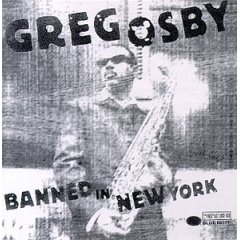
St Louis-born alto saxophonist
Greg Osby
relocated to New York in 1984
where he joined Jack DeJohnette's group and became a member of the
M-Base Collective.
The funk-jazz style of the latter permeated the albums of
his guitar and keyboards quintets:
Sound Theatre (june 1987) and Mind Games (may 1988).
Season of Renewal (july 1989) added wordless vocals by Amina Claudine Myers and Cassandra Wilson to the leader's dissonant solos over funky rhythm.
Osby pioneered the fusion of jazz and hip-hop music on 3D Lifestyles (october 1992).
TM, ®, Copyright © 2006 Piero Scaruffi All rights reserved.
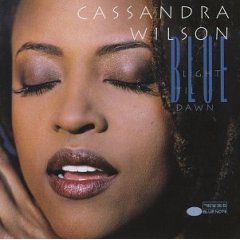
Mississippi-born vocalist Cassandra Wilson relocated to New York in 1982 where she became the most famous member of the M-Base Collective.
She blossomed with New Moon Daughter (1995), when she started borrowing from the whole canon of popular music (folk, blues, country, soul, rock) to mold her own voice, a project continued on Belly of the Sun (2002) and Glamoured (march 2003), that feature more of her own compositions.
TM, ®, Copyright © 2006 Piero Scaruffi All rights reserved.
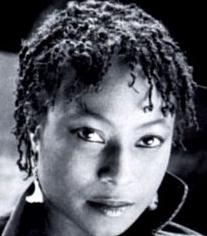
Detroit-born pianist Geri Allen, a graduate in ethnomusicology, moved to New York in 1982.
She collaborated with Oliver Lake (1984-87) and with Steve Coleman (1986-88), and joined the M-Base collective.
Allen's debut album, The Printmakers (february 1984), in a trio
with bassist Anthony Cox and percussionist Andrew Cyrille, was an original
offering of dissonant and free jazz,
but subsequent recordings moved rapidly towards the lightweight and superficial
end of the spectrum.
She preferred to fragment her albums into short pieces rather than attempt
the epic-length suite or jam. Collections of original compositions were
The Nurturer (january 1990), featuring
Marcus Belgrave on trumpet and flugelhorn, Kenny Garrett on alto saxophone, bass and two percussionists,
and especially Maroons (february 1992) with one or more trumpet, bass and drums (Feed The Fire, Laila's House, Mad Money).
Some Aspects of Water (march 1996) contained two of her longest
compositions ever: the ten-minute Skin for a piano-bass-drums trio,
and the 19-minute Some Aspects of Water for nonet.
Gathering (february 1998) was another collection of (Allen-composed)
atmospheric chamber-jazz pieces for various combinations of instruments,
but faithful to a radio-friendly ideology that ran the gamut from
new-age music to jazz-rock.
After a six-year hiatus, Allen led a more serious trio with
bassist Dave Holland and drummer Jack DeJohnette on
The Life Of A Song (january 2004), although the material was still
rather lightweight, with few notable exceptions
(Mounts And Mountains, The Experimental Movement).
TM, ®, Copyright © 2006 Piero Scaruffi All rights reserved.
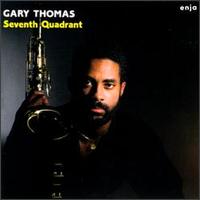
Tenor saxophonist and flutist Gary Thomas established himself as one of the most jarring soloists of his generation, especially against somewhat chaotic backdrops such as the electronic-tinged accompaniment of guitar, keyboards, bass and drums on Seventh Quadrant (april 1987) and Code Violations (july 1988). He kept antagonizing the tradition of jazz with By Any Means Necessary (may 1989), featuring (among others) alto saxophonist Greg Osby, keyboardist Geri Allen, guitarist John Scofield, bassist Anthony Cox and percussionist Nana Vasconcelos, and The Kold Kage (june 1991), that experimented with synthesizer, turntable and rapping, always displaying a passion for uncharted territories..
TM, ®, Copyright © 2006 Piero Scaruffi All rights reserved.

Texan pianist Jason Moran found a compromise between impressionist
classical music, energetic bebop and moody new-age music on
Soundtrack to Human Motion (september 1998), arranged for a small ensemble, and Black Stars (march 2001), for a quartet with Sam Rivers. The
solo piano program of Modernistic (april 2002) used studio effects to bridge
ancient jazz piano and contemporary sound.
TM, ®, Copyright © 2006 Piero Scaruffi All rights reserved.
Acid Jazz
TM, ®, Copyright © 2006 Piero Scaruffi All rights reserved.
In 1988 the British disc-jockey Gilles Peterson coined the term "acid jazz"
for his mixes of jazz records (mostly funk-jazz) and hip-hop. This style became
a sensation in London and eventually migrated to the USA.
The term "acid-jazz" came to denote the successor of fusion jazz, a hybrid
style that borrowed from funk, soul, rock, jazz and, last but not least, the
post-disco dance styles (such as "acid house", that was peaking at about the
time that acid-jazz was starting out).
The "acid-jazz" scene of San Francisco was pioneered by the
Broun Fellinis, formed in 1991 by saxophonist David Boyce, bassist Ayman Mobarak and drummer Kevin Carnes, (a former member or the rock group Beatnigs),
and the Alphabet Soup, formed in 1991 by saxophonist Kenny Brooks, pianist Dred Scott, rapper Chris Burger, and drummer Jay Lane.
San Francisco, an ideal meeting point of the most open-minded traditions of
rock, jazz and hip-hop music, soon became the headquarter of the movement.

In 1993 San Francisco's white guitarist
Charlie Hunter,
a former musical partner of white rapper Michael Franti and member of his rap-rock group Disposable Heroes of Hiphoprisy (1992), formed a bass-less trio with tenor saxophonist Dave Ellis and drummer Jay Lane (a former member of the rock group Primus) that heralded the golden age of acid-jazz.
After the funky mini-orgies of Charlie Hunter Trio (may 1993),
Hunter embraced a custom-made eight-string guitar (that allowed him to play rhythm and melody simultaneously) and added a more sophisticated
jazz touch to Bing Bing Bing (1995).
Scott Amendola replaced Lane before Ready Set Shango (1996),
that also added saxophonist Calder Spanier to the line-up, thus turning the trio
into a quartet.
Ellis was replaced by Kenny Brooks of Alphabet Soup
while trumpeter Chuck MacKinnon, vibraphonist Stefon Harris and
percussionist John Santos were added to form a septet, renamed Pound For Pound.
However, Hunter disposed of the horns and pared down the band to a quartet of
guitar, drums, percussion and vibraphone for Return of the Candyman (september 1997).
These were all fun albums that were popular with the intellectual disco crowd because they focused on the groove.
TM, ®, Copyright © 2006 Piero Scaruffi All rights reserved.
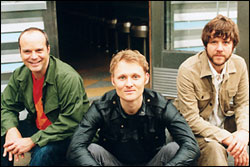
In the 1990s the New York scene of groove-based jazz was dominated by
Medeski Martin & Wood:
keyboardist John Medeski, bassist Chris Wood and drummer Billy Martin,
all of them white.
The acoustic Notes From the Underground (january 1992), on which Medeski
played a grand piano and penned the lengthy Querencia, achieved an inspired fusion of jazz tradition with funky and hip-hoppish rhythms.
But the highlights of the electric and commercial It's a Jungle in Here (august 1993) were Afro-funk and reggae covers.
They settled on a compromise on Friday Afternoon In The Universe (july 1994), that was basically an album of old-fashioned soul-jazz with the neurotic accent of the 1990s (The Lover, We're So Happy).
They plunged into late-night lounge-music with the languid Shack Man (june 1996), but resurrected with Farmer's Reserve (february 1997), a set of free improvisations,
with Combustication (1998), featuring collaborations with turntablist Jason "DJ Logic" Kibler as well as acoustic pieces (Latin Shuffle),
with the dense soundscape of The Dropper (2000), featuring cellist Jane Scarpantoni and guitarist Marc Ribot,
and with the even more abstract Uninvisible (2001), enhanced with horns and turntables.
TM, ®, Copyright © 2006 Piero Scaruffi All rights reserved.
New-age jazz
In 1975 Palo Alto-based guitarist William Ackerman coined the term "new-age music" and founded a record label, Windham Hill, to promote atmospheric instrumental acoustic music.
New-age music was, first and foremost, a synthesis,
straddling the border between jazz, classical and folk music (and eventually also
psychedelic and electronic music).
The term "new age" was a reference to the spiritual mood that had
taken hold of the hippy generation. The former hippies now constituted an
appealing market segment (many of them having become yuppies). Thus new-age
music was peaceful music meant to reflect the harmony of nature, music
permeated by a spiritual, pantheistic and pan-ethnic mood, and therefore
music heavily influenced by Eastern religion/philosophy.
Since it targeted the middle-aged urban professionals, new-age music
was music made by white folks for white folks, and therefore related
to the ECM generation of white jazz musicians.
It was also mostly based on the West Coast.
Tony Scott's Music For Zen Meditation (february 1964) and Paul Horn's
In India (1967) were largely responsible for the marriage of
jazz and Eastern music that laid the foundations for new-age music
of the 1980s.
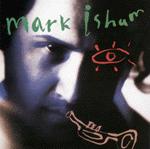
San Francisco-based white trumpeter Mark Isham, a former member of Art Lande's Rubisa Patrol in Scandinavia (1976) and of the prog-rock quartet Group 87 (1978) with guitarist Peter Maunu, bassist Patrick O'Hearn and drummer Terry Bozzio, wed his oneiric Miles Davis-influenced technique with chromatically haunting synthesizers on Vapor Drawings (may 1983), a cycle of meticulously-arranged impressionistic vignettes (with all instruments played by him except drums). Less electronics and a real group (guitarist David Torn, Oregon's reed-player Paul McCandless, Japan's bassist Mick Karn plus former Group 87 buddies Maunu, O'Hearn and Bozzio) gave Castalia (1988) a sound closer to Weather Report-style jazz-rock. It all came together on the five-movement symphony Tibet (1989) for a chamber ensemble (including flutist Bill Douglas, guitarists Maunu and Torn), a majestic fusion of jazz, electronics, ambient music and world-music.
TM, ®, Copyright © 2006 Piero Scaruffi All rights reserved.

White cellist David Darling, a member of Paul Winter's Consort, specialized in solemn, highly chromatic and almost baroque meditations straddling classical, jazz and Eastern music. Journal October (october 1979), his first solo, and Cycles (november 1981), that featured saxophonist Jan Garbarek, pianist Steve Kuhn, sitarist Collin Walcott, guitarist Oscar Castro-Neves and bassist Arild Andersen in various configurations, were mainly demonstrations of his glacial technique. After a long hiatus, Darling penned a trilogy of performances in solo settings, often overdubbing his acoustic and electric cellos: The Tao Of Cello (1989), a set of 22 brief improvised interludes reminiscent of Chinese philosophy; Cello (january 1992), that debuted the medieval-inspired "Darkwood" series of adagios; Darkwood (july 1993), containing four more multi-part suites of the "Darkwood" series (4 to 7), his most austere effort in the realm of neoclassical music; and finally Eight String Religion (1993), recorded over eleven years, that added his own piano playing and natural sounds.
TM, ®, Copyright © 2006 Piero Scaruffi All rights reserved.
The emphasis of new-age music on solo acoustic instruments yielded pensive and impressionistic albums that were basically structured as free-form melodic fantasias:
George Winston's Autumn (june 1980) for the piano,
Georgia Kelly's The Sound Of Spirit (october 1981) for the harp,
Daniel Kobialka's Echoes Of Secret Silence (1982) for the violin,
Frank Perry's Deep Peace (october 1980) for percussion instruments,
etc.
Pianists outnumbered any other instrumentalists.

Canadian pianist Michael Jones, the new-age master of the lyrical stream of consciousness, penned the psychological double-CD concept Pianoscapes (january 1981), the impressionistic trilogy of Windsong (may 1982), Seascapes (january 1984) and Sunscapes (december 1985), the sophisticated cello-piano duets of Amber (march 1987) with David Darling, the majestic chamber music of After The Rain (december 1987) with Darling and oboe player Nancy Rumbel, one of new-age's melodic zeniths, and the four ambitious suites of Air Born (february 1994).
TM, ®, Copyright © 2006 Piero Scaruffi All rights reserved.
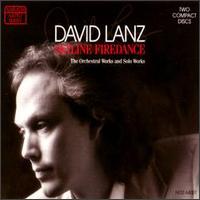
Seattle-born white pianist David Lanz specialized in domestic vignettes based on folkish melodies and tempos, such as Heartsounds (june 1983) and especially the longer ones of Nightfall (september 1984) and Cristofori's Dream (april 1988). While baroque pomp permeated the Skyline Firedance (may 1990), conceived as micro-symphonic poems. Lanz was emblematic of new-age music's strategy of ransacking the vocabulary of classical music, from the madrigal to the adagio.
TM, ®, Copyright © 2006 Piero Scaruffi All rights reserved.
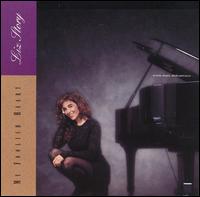
The introspective art of California pianist Liz Story on Solid Colors (1983), Speechless (1988) and Escape Of The Circus Ponies (1991) evoked the brilliancy of Keith Jarrett's style but remained anchored to the folk and classical tradition.
Another category of soloists that found a broader audience thanks to new-age
music was that of percussionists.

New York's percussionist
Mark Nauseef
combined Indonesian, Indian, African, rock, jazz and minimalist techniques on
the esoteric Sura (january 1983), featuring the jazz supergroup with Steve Kuhn on keyboards, Markus Stockhausen on horns, Trilok Gurtu on percussion, David Torn on guitar and a cornucopia of exotic instruments,
and on the solo tour de force of Wun Wun (may 1984), with rock vocalist Jack Bruce, a timbric feast at times reminiscent of avantgarde electronic music.
Nauseef partnered with Serbian guitarist Miroslav Tadic for a series of
notably The Snake Music (june 1993), that featured Bruce, Markus Stockhausen, guitarist David Torn, German saxophonist Wolfgang Puschnig and Walter Quintus on computers,
and Still Light (march 1993), a trio with German reed player Markus Stockhausen.
Nauseef also tried to coin "sufi-jazz" on two collaborations with Turkish ney virtuoso Kudsi Erguner: Ottomania (may 1998)
and Islam Blues (may 2000), which also featured
Vietnamese guitarist Nguyen Le, French contrabassist Renaud Garcia-Fons and Turkish singers and musicians.
TM, ®, Copyright © 2006 Piero Scaruffi All rights reserved.
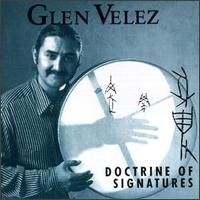
Texan percussionist Glen Velez,
who had worked with Steve Reich (1972) and Paul Winter (1983),
devoted himself to the frame drum on
Handance (1983) and Internal Combustion (may 1985), accompanied
only by fellow percussionist Layne Redmond.
Seven Heaven (may 1987) added flutist Steve Gorn, and
Assyrian Rose (june 1989), his first "melodic" work, added French horn, harmonica and piano to the frame drums and the flute.
The 45-minute Doctrine Of Signatures for five frame drums, off Doctrine Of Signatures (december 1990), was his aesthetic peak.
TM, ®, Copyright © 2006 Piero Scaruffi All rights reserved.
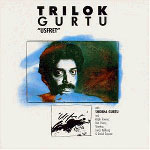
Indian percussionist Trilok Gurtu, the son of vocalist Shobha Gurtu, who had played with Don Cherry (1976), with Oregon (1984) and with John McLaughlin (1989),
perfected a technique that draws equally from Indian tabla and dhol drums,
from jazz music (cymbals, hi-hats) and from other ethnic cultures
(gongs, congas, cowbells, snares).
He even dipped resonating instruments in buckets of water to produce sounds
that he could not produce with traditional instruments.
He began his mission with
the intense mixture of Indian music, jazz-rock and world-music of the double-CD Usfret (1988), featuring the likes of trumpeter Don Cherry, guitarist Ralph Towner, Indian violinist Lakshminarayana Shankar, Swedish bassist Jonas Hellborg, French keyboardist Daniel Goyone and his own mother, vocalist Shobha, although the album still downplayed the exotic overtones and emphasized instead supernatural spirituality.
His world horizons further expanded on Living Magic (march 1991), performed by a multinational septet with Goyone, Norwegian saxophonist Jan Garbarek, Brazilian percussionist Nana Vasconcelos, Belgian bassist Nicolas Fiszman, British kora player Tunde Jegede and Indian veena player Shanthi Rao.
Electronic keyboards and a lot more jazz reduced the world-music element on the trilogy that followed: Crazy Saints (june 1993), featuring Goyone, keyboardist Joe Zawinul, guitarist Pat Metheny, Dutch cellist Ernst Reijseger, French bassist Marc Bertaux;
Believe (july 1994), for a more regular quartet (Goyone, Vietnamese bassist Chris Minh Doky and guitarist David Gilmore);
and the live
Bad Habits Die Hard (october 1996) by the same quartet but with Andy Emler replacing Goyone on keyboards (and saxophonist Bill Evans and violinist Mark Feldman guesting).
However, Gurtu later embarked on a project to fuse African and Indian music while retaining the western song-oriented format on the following trilogy: The Glimpse (september 1996), whose core was an Oregon-like ensemble with Emler, Bulgarian flutist Teodosii Spassov and Indian-American guitarist Jaya Deva; Kathak (december 1997), an Afro-Indian-jazz jam with Swedish bassist Kai Eckhardt de Camargo, Moroccan guitarist Jaya Deva, Indian sitar player Ravi Chary and vocalist Neneh Cherry; and African Fantasy (2000), performed by a mixed African-Indian ensemble (Chary, Fiszman, Deva and several African vocalists).
TM, ®, Copyright © 2006 Piero Scaruffi All rights reserved.
New York-based steel-pans virtuoso Andy Narell introduced Trinidad's national instrument to jazz music with the exuberant, melodic pan-ethnic sonatas of The Hammer (1987) and Little Secrets (1989).
California's contrabassist Bob Wasserman borrowed from David Grisman's progressive bluegrass, acid-rock and free jazz to pen his first album Solo (1983) and the Trios (1994) that featured rock, jazz, folk and blues musicians.
New-age instrumentalists also merged in configurations of simple counterpoint
that evoked both chamber jazz and chamber classical music.
San Francisco-based guitarist Teja Bell
presided over three of the best examples of chamber new-age music.
Pianist Marcus Allen
assembled a quartet with
Bell, lyricon player Dallas Smith and vibraphonist John Bernoff
for his Petals (1981).
Then the three without Allen recorded
Summer Suite (1983).
And Mahavishnu Orchestra's violinist Steve Kindler's Dolphin Smiles (1987) featured Bell and a percussionist.
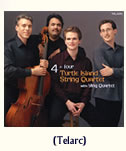
Shadowfax
created the standard for the new-age acoustic ensemble with chromatically-rich
and melodically-relaxing albums such as Shadowdance (1983).
Significant contributions to the "chamber" wing of new-age music came from
former members of David Grisman's quintet, whose "jazzgrass" lent itself to
a neo-classical interpretation.
Violinist Darol Anger, pianist Barbara Higbie, mandolinist Mike Marshall, and bassist Michael Manring formed Montreux, that
released borderline albums such as Sign Language (february 1987) and
Let Them Say (january 1989), and Anger led their
spin-off, the Turtle Island String Quartet
(Anger, violinist David Balakrishnan, cellist Mark Summer, viola player Irene Sazer), whose Turtle Island String Quartet (july 1987), mostly composed by
Balakrishnan, perfected those ideas.
TM, ®, Copyright © 2006 Piero Scaruffi All rights reserved.
The subtle fusion of different musical universes (jazz, rock, minimalism, ambient) was not lost on the next generation of jazz groups.
Post-fusion
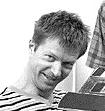
Los Angeles-based guitarist Nels Cline
opened a new front of jazz-rock cross-fertilization, being both a
fusion guitarist who played post-rock and
a post-rock guitarist who played jazz.
As a composer, he matured on Angelica (august 1987), featuring saxophonist Tim Berne, Von Essen, drummer Alex Cline and trumpeter Stacey Rowles.
Cline formed a power trio in a fashion similar to what Bill Frisell had done,
and recorded equally eclectic tours de force, such as
Silencer (december 1990) and Chest (july 1995).
However, it was The Inkling (may 1999), recorded by a quartet (with Zena Parkins on harp), and the Instrumentals (august 2001) for a power-rock trio, with the free-form jam Blood Drawing, that succeeded in redefining fusion jazz in the age of post-rock.
The latter inaugurated the all-instrumental series of the Nels Cline Singers,
that reached another peak with Draw Breath (february 2007), featuring
the 16-minute An Evening At Pops and the 15-minute Mixed Message.
His syncretic and diverse approach to music also yielded:
the punk-jazz suite As In Life, off Destroy All Nels Cline (july 2000), scored for four guitarists and a rhythm section;
the high-energy jam Immolation Immersion, off Immolation/Immersion (april 2005) in a trio with saxophonist Wally Shoup and percussionist Chris Corsano;
the six-movement chaos-rock suite Onan and
the austere pan-ethnic string-instrument chamber sonata and requiem Rod Poole's Gradual Ascent to Heaven, off Coward (april 2008).
Each new album was not only a catalog og guitar techniques but also
a kaleidoscope of transfigured genres (country, rock, jazz, Eastern).
TM, ®, Copyright © 2006 Piero Scaruffi All rights reserved.
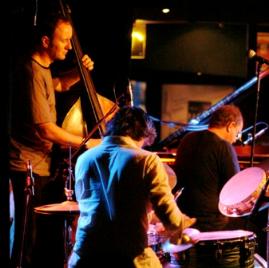
The Necks, an Australian combo formed by three veteran session-men (pianist Chris Abrahams, drummer Tony Buck, bassist Lloyd Swanton), specialized in lengthy (usually album-length), trancey jams anchored to simple melodic lines and sometimes propelled by swinging, funky grooves.
These "jams" were actually studio constructions, i.e. the result of a
painstaking mixing and editing process.
The insistent repetition of harmonic elements harked back to
minimalism while the fluid and atmospheric interplay evoked jazz-rock.
Sex (1989) was the archetype of how to make cascading piano notes coalesce in hypnotic streams of casual tones.
The subdued rhythm and slightly syncopated tempo created a delicate texture
for the intermittent patterns of neoclassical piano and sensual trumpet wails.
The way Abrahams caressed the piano was both abstract, exotic and romantic.
The style of their meditations, based on slow, fragile, colloquial interplay,
reached maturity with White, off the double-CD Silent Night (september 1995).
The formula was repeated on Hanging Gardens (january 1999), a cryptic if not gothic piece that underwent several mutations,
and especially Aether (2000), perhaps the most "ambient" of their hour-long pieces, in which a simple chord was repeated like a mantra to elicit a cosmic drone that led the music into an ecstatic crescendo of counterpoint.
The latter was, in turn, the blueprint for the dreamy ambience and fluent dynamics of Drive By (2003), the ultimate secretion of Miles Davis, Terry Riley and Brian Eno, while
See Through, off Mosquito/ See Through (2005), was both a miracle of contained chaos and suspense and a showcase of piano jazz soliloquy.
TM, ®, Copyright © 2006 Piero Scaruffi All rights reserved.
Yeah No (clarinetist and saxophonist Chris Speed, Vietnamese-born trumpeter Cuong Vu, Icelandic-born bassist Skuli Sverrisson, drummer Jim Black) were jazz musicians playing Eastern European folk melodies and dance rhythms, starting with Yeah No (july 1996), a concept similar to Lol Coxhill's Welfare State.
TM, ®, Copyright © 2006 Piero Scaruffi All rights reserved.
The Claudia Quintet, formed in 1997 by drummer John Hollenbeck, merged chamber music's timbral exploration, jazz improvisation, post-rock's rhythmic eccentricities and minimalist repetition on albums scored for clarinet (Yeah No's clarinetist and saxophonist Chris Speed), accordion (Ted Reichman), vibraphone (Matt Moran), bass (Drew Gress) and percussion:
Claudia Quartet (january 2001), with the ambience of Thursday 11:14am and the dischordant No D marking a vast stylistic territoty;
and I Claudia (2003), displaying influences that range from
Frank Zappa to Steve Reich to gamelan to Middle-eastern music to LaMonte Young.
Hollenbeck was emblematic of a new generation of jazz composers who were straddling the border between jazz, classical, rock, ethnic and electronic music.
TM, ®, Copyright © 2006 Piero Scaruffi All rights reserved.
Next chapter | Back to the Index
|


















